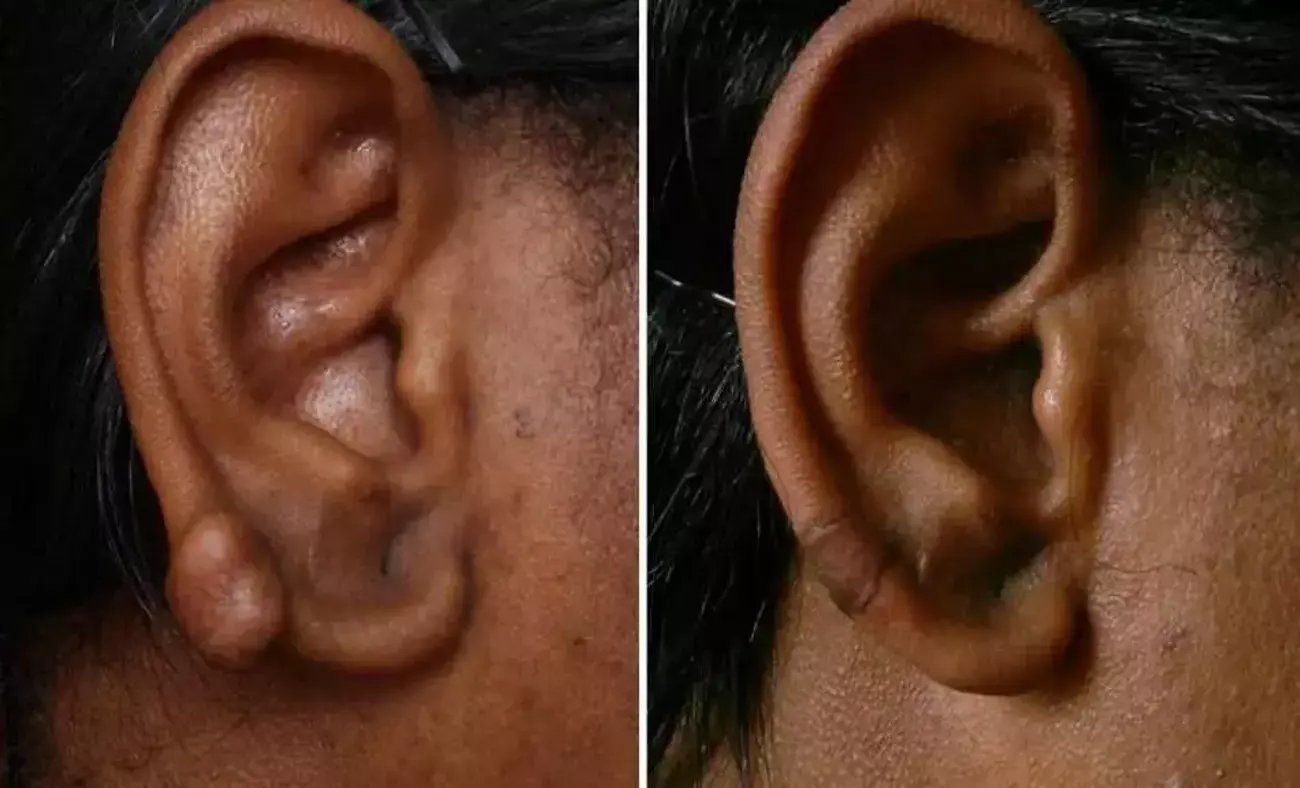What is Keloid Scar?
Causes and Prevention of Keloid Scars
A keloid scar is a type of raised scar that extends beyond the boundaries of the original wound or incision. These scars can be unsightly and, in some cases, cause discomfort or pain. Understanding keloid scars, their symptoms, causes, and prevention measures can help individuals manage and potentially avoid these scars altogether.

Symptoms of Keloid Scars
Keloid scars are characterized by their raised, thick, and often shiny appearance. Some common symptoms and characteristics of keloid scars include:
1. Elevated Texture: Keloid scars rise above the skin's surface and can feel firm to the touch.
2. Red or Darkened Color: They may be pink, red, or darker in color than the surrounding skin.
3. Itching and Discomfort: Keloid scars can be itchy and, in some cases, cause discomfort or pain.
4. Growth Over Time: These scars may continue to grow for several weeks or even months after the initial injury.
When to See a Doctor
The first sign that you should consult a doctor is if you notice the formation of a keloid scar. Early intervention can help control their growth. Keloids can occur on any part of the body, but they are more common in areas with little fatty tissue, such as the chest, back, shoulders, and earlobes. If your keloid scar is causing discomfort, itchiness, or pain, it's essential to seek medical advice.
Additionally, if your keloid scar hinders your range of motion, affects your self-esteem, or causes emotional distress, consulting a doctor is a wise decision. Doctors can recommend various treatments, including steroid injections, silicone gel sheets, laser therapy, or surgical removal, depending on the severity of the keloid.
People with a history of keloid formation or those with a family history of keloids should be vigilant and consider seeing a doctor at the first sign of keloid development. Early intervention and appropriate treatment can help prevent excessive growth and discomfort.
Suppose you suspect or notice the formation of a keloid scar, experiencing pain or discomfort, or have emotional distress due to a keloid. In that case, it is advisable to consult a doctor promptly. Timely medical intervention can assist in managing keloids effectively and improving your overall well-being.
Our mission is to create a world where every investment in modern beauty is Worth It.
Let's keep in touch
Get updates of the treatments you are interested
Causes of Keloid Scars
The exact cause of keloid scars is not fully understood, but several factors contribute to their development, including:
1. Genetics: Keloid susceptibility can be hereditary, meaning individuals with a family history of keloid scars are at a higher risk.
2. Injury or Surgery: Any form of skin trauma, such as cuts, burns, surgical incisions, or even acne, can trigger keloid scar formation.
3. Skin Type: People with darker skin tones are more prone to keloid scars.

Risk Factors for Keloid Scars
Several risk factors increase the likelihood of developing keloid scars, including:
1. Age: Keloid scars are more common in people under 30.
2. Gender: Both men and women can develop keloid scars, but they tend to be more prevalent in women.
3. Location of Injury: Certain areas of the body, such as the chest, shoulders, earlobes, and upper back, are more prone to keloid formation.
Complications Associated with Keloid Scars
While keloid scars are generally harmless, they can lead to some complications, including:
1. Pain and Discomfort: Large keloids can be painful and cause discomfort.
2. Self-esteem and Psychological Impact: Keloid scars may affect self-esteem and body image, leading to psychological distress in some individuals.

Prevention of Keloid Scars
Preventing keloid scars can be challenging, but several strategies can help reduce the risk:
1. Wound Care: Properly care for wounds, burns, and surgical incisions by keeping them clean and covered to minimize the risk of infection and excessive scarring.
2. Silicone Gel Sheets: Some individuals find relief from using silicone gel sheets or dressings on healing wounds to minimize scarring.
3. Corticosteroid Injections: In some cases, corticosteroid injections can help flatten and reduce the size of keloid scars.
4. Pressure Dressings: Pressure dressings can be applied to reduce tension on the wound and prevent keloid formation.
5. Radiation Therapy: In certain situations, radiation therapy may be considered after surgical removal of keloid scars to prevent recurrence.
Keloid scars can be a source of concern for many individuals, but understanding their symptoms, causes, risk factors, complications, and prevention measures can help manage and reduce the risk of developing these scars. Seeking medical advice and early intervention are crucial steps in addressing keloid scars effectively.
Our mission is to create a world where every investment in modern beauty is Worth It.
Let's keep in touch
Get updates of the treatments you are interested
Causes and Prevention of Keloid Scars
A keloid scar is a type of raised scar that extends beyond the boundaries of the original wound or incision. These scars can be unsightly and, in some cases, cause discomfort or pain. Understanding keloid scars, their symptoms, causes, and prevention measures can help individuals manage and potentially avoid these scars altogether.

Symptoms of Keloid Scars
Keloid scars are characterized by their raised, thick, and often shiny appearance. Some common symptoms and characteristics of keloid scars include:
1. Elevated Texture: Keloid scars rise above the skin's surface and can feel firm to the touch.
2. Red or Darkened Color: They may be pink, red, or darker in color than the surrounding skin.
3. Itching and Discomfort: Keloid scars can be itchy and, in some cases, cause discomfort or pain.
4. Growth Over Time: These scars may continue to grow for several weeks or even months after the initial injury.
When to See a Doctor
The first sign that you should consult a doctor is if you notice the formation of a keloid scar. Early intervention can help control their growth. Keloids can occur on any part of the body, but they are more common in areas with little fatty tissue, such as the chest, back, shoulders, and earlobes. If your keloid scar is causing discomfort, itchiness, or pain, it's essential to seek medical advice.
Additionally, if your keloid scar hinders your range of motion, affects your self-esteem, or causes emotional distress, consulting a doctor is a wise decision. Doctors can recommend various treatments, including steroid injections, silicone gel sheets, laser therapy, or surgical removal, depending on the severity of the keloid.
People with a history of keloid formation or those with a family history of keloids should be vigilant and consider seeing a doctor at the first sign of keloid development. Early intervention and appropriate treatment can help prevent excessive growth and discomfort.
Suppose you suspect or notice the formation of a keloid scar, experiencing pain or discomfort, or have emotional distress due to a keloid. In that case, it is advisable to consult a doctor promptly. Timely medical intervention can assist in managing keloids effectively and improving your overall well-being.
Our mission is to create a world where every investment in modern beauty is Worth It.
Let's keep in touch
Get updates of the treatments you are interested
Causes of Keloid Scars
The exact cause of keloid scars is not fully understood, but several factors contribute to their development, including:
1. Genetics: Keloid susceptibility can be hereditary, meaning individuals with a family history of keloid scars are at a higher risk.
2. Injury or Surgery: Any form of skin trauma, such as cuts, burns, surgical incisions, or even acne, can trigger keloid scar formation.
3. Skin Type: People with darker skin tones are more prone to keloid scars.

Risk Factors for Keloid Scars
Several risk factors increase the likelihood of developing keloid scars, including:
1. Age: Keloid scars are more common in people under 30.
2. Gender: Both men and women can develop keloid scars, but they tend to be more prevalent in women.
3. Location of Injury: Certain areas of the body, such as the chest, shoulders, earlobes, and upper back, are more prone to keloid formation.
Complications Associated with Keloid Scars
While keloid scars are generally harmless, they can lead to some complications, including:
1. Pain and Discomfort: Large keloids can be painful and cause discomfort.
2. Self-esteem and Psychological Impact: Keloid scars may affect self-esteem and body image, leading to psychological distress in some individuals.

Prevention of Keloid Scars
Preventing keloid scars can be challenging, but several strategies can help reduce the risk:
1. Wound Care: Properly care for wounds, burns, and surgical incisions by keeping them clean and covered to minimize the risk of infection and excessive scarring.
2. Silicone Gel Sheets: Some individuals find relief from using silicone gel sheets or dressings on healing wounds to minimize scarring.
3. Corticosteroid Injections: In some cases, corticosteroid injections can help flatten and reduce the size of keloid scars.
4. Pressure Dressings: Pressure dressings can be applied to reduce tension on the wound and prevent keloid formation.
5. Radiation Therapy: In certain situations, radiation therapy may be considered after surgical removal of keloid scars to prevent recurrence.
Keloid scars can be a source of concern for many individuals, but understanding their symptoms, causes, risk factors, complications, and prevention measures can help manage and reduce the risk of developing these scars. Seeking medical advice and early intervention are crucial steps in addressing keloid scars effectively.










